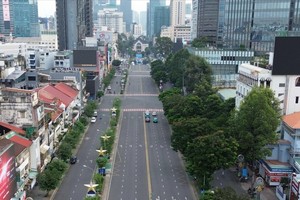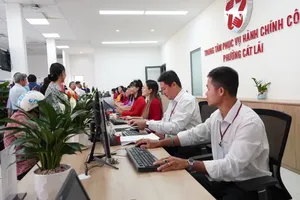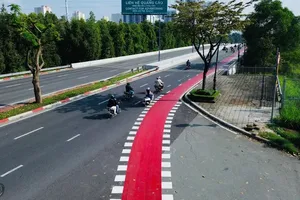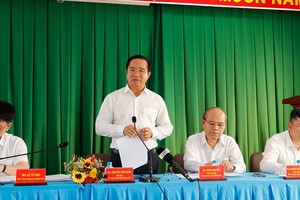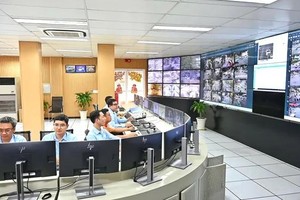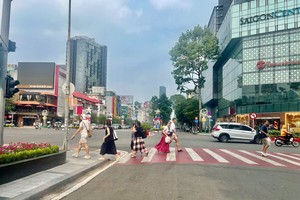 A section of Tham Luong - Ben Cat - Nuoc Len canal
A section of Tham Luong - Ben Cat - Nuoc Len canal
For decades, the Tham Luong - Ben Cat - Nuoc Len canal in districts 12, Binh Tan, Tan Phu, Tan Binh, Go Vap, Binh Thanh and Binh Chanh has become a nightmare for residents on both sides of the canal as the canal water gives off a foul smell. When it rains, the stench hits the noses of passersby and residents living on both sides of the canal.
Local Tran Thi Ngoc in Thoi An ward in District 12 hoped that competent authorities in Ho Chi Minh City will soon have a solution so that locals living by the canal will not endure its stench, which affects not only their senses but also their livelihoods.
Data from the Technical Infrastructure Division under the Ho Chi Minh City Department of Construction said that the southern largest city only has three urban wastewater treatment plants including Binh Hung with a capacity of 141,000 cubic meters a day, Binh Hung Hoa with 30,000 cubic meters a day and Tham Luong - Ben Cat with 15,000 cubic meters a day.
In addition, several other wastewater treatment stations are located in residential areas.
With these plants, the total amount of treated wastewater currently accounts for only 12.6 percent. According to statistics, the amount of urban wastewater generated in the city is about 1.54 million cubic meters a day.
Untreated wastewater is discharged directly into the environment, polluting surface water and affecting people's daily life. In recent years, The amount of wastewater discharged into the environment has continuously increased; for instance, from 2018 to 2021, the average wastewater rate is estimated to increase by 6.7 percent each year.
According to a leader of the Department of Construction, HCMC strives that by 2025, about 80 percent of the city's total wastewater volume (nearly 2.6 million cubic meters a day) will be collected and treated up to standards before being discharged into the environment. To achieve this goal, Ho Chi Minh City will focus on building a wastewater treatment plant and implementing an environmental sanitation project in Nhieu Loc - Thi Nghe area in the second phase which is stated to complete in 2024.
Along with that, in the period 2021-2025, the southern metropolis called for investment in six wastewater treatment plants comprising North Saigon 1, North Saigon 2, Cau Dua, Northwest, West Saigon, and Suoi Nhum which will be completed between 2026 to 2030.
Currently, Ho Chi Minh City is investing in a number of projects including the consolidation of factories Tan Hoa - Lo Gom with a capacity of 300,000 cubic meters a day, Binh Tan with a capacity of 180,000 cubic meters a day and Saigon West with a capacity of 150,000 cubic meters a day which is expected to finish in 2030.
The southern metropolis is also upgrading and expanding Binh Hung Wastewater Treatment Plant to raise the capacity from 141,000 cubic meters a day to 469,000 cubic meters a day and Nhieu Loc - Thi Nghe factory has a capacity of 480,000 cubic meters a day.
Mr. Vu Van Diep, Director of the Technical Infrastructure Management Center said that responsible departments and agencies have been urgently reviewing the land fund, planting landmarks at different locations where wastewater treatment plants will be built according to plan in addition to reform of administrative procedures and acceleration of projects.
According to Deputy Director of Ho Chi Minh City Department of Construction Dang Phu Thanh, the big investment cost of the drainage and wastewater treatment system is the current difficult problem; plus, the construction of a domestic wastewater treatment plant requires a large area of land; thereby, site clearance is bumping in difficulties.
In order to attract investment resources for this field, the municipal People's Committee of Ho Chi Minh City has issued a price for drainage and wastewater treatment services. Ho Chi Minh City also called for ODA capital from the Japan International Cooperation Agency, the World Bank, and Asian Development Bank and promote the socialization of investment in drainage and wastewater treatment works, calling for investment in the form of public-private partnership to create more capital.
In June 2021, the People's Committee of Ho Chi Minh City officially issued the price of water drainage and wastewater treatment services in the city for the period of 2022-2025. Agencies, organizations, and households that discharge domestic wastewater into the drainage system and receiving sources will pay for the water drainage and wastewater treatment services as per new prices.









